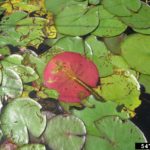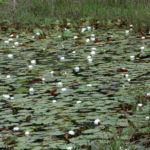Gallery:
- Fragrant water lily
- Fragrant water lily with pink flowers
- Fragrant water lily leaves, showing reddish underside
- Fragrant water lily infestation
Common names:
Fragrant water lily, tuberous water lily, white water lily
Scientific Name:
Nymphaea odorata
Description:
Fragrant water lily is a floating perennial aquatic plant in the Nymphaeaceae (water lily) family. The leaves are rounded with a slit, have smooth margins, and the undersides are typically reddish or purplish. The leaves and flowers are attached to stalks that grow from rhizomes (underground stems) in the muddy bottom. It also has long stolons that float just below the water’s surface. The flowers are showy, with yellow centers and about 20 to 40 white (sometimes pink or pale yellow) petals. It spreads through seeds that float and rhizome fragments that break off.
Life cycle:
Height of mature plants
The flowers and leaves float on the water’s surface, stems extend down to the mud, up to 7 feet.
Flower color:
white to pink, sometimes pale yellow
Bloom time:
June to October
Look-a-likes:
Fragrant water lily looks similar to yellow water lily, although the flowers are quite different (white/pink vs. bright yellow). Both species have floating leaves with a slit, although yellow floating heart leaves are more elliptic and have veins that extend to the edges of the leaf. The veins on fragrant water lily don’t extend to the edge and form a net-like pattern.
Habitat:
It prefers lakes, ponds, that are 3 to 7 feet deep and have mucky to silty bottoms. It can also grow in slow-moving ditches or streams, and can grow in a wide pH range.
Impacts:
Fragrant water lily can spread quickly, forming dense floating mats that cover hundreds of acres and crowd out other plants, block access and restrict passage for boats and swimmers. The floating mats can also alter water quality by increasing temperature, decreasing oxygen and contributing to algal growth. Stagnant mats can also provide mosquito breeding areas. In Washington state, drownings have occurred when swimmers were caught in the dense, tangled stems.
Noxious Weed Listing:
- WeedWise:
- State of Oregon: not listed
- State of Washington: Class C
- Four County CWMA: Class D
- Columbia Gorge CWMA: Class C
Origin:
Eastern North America
Links:
Washington Noxious Weed Profile
Invasive.org profile
King County Noxious Weed Profile
Global Invasive Species Database




